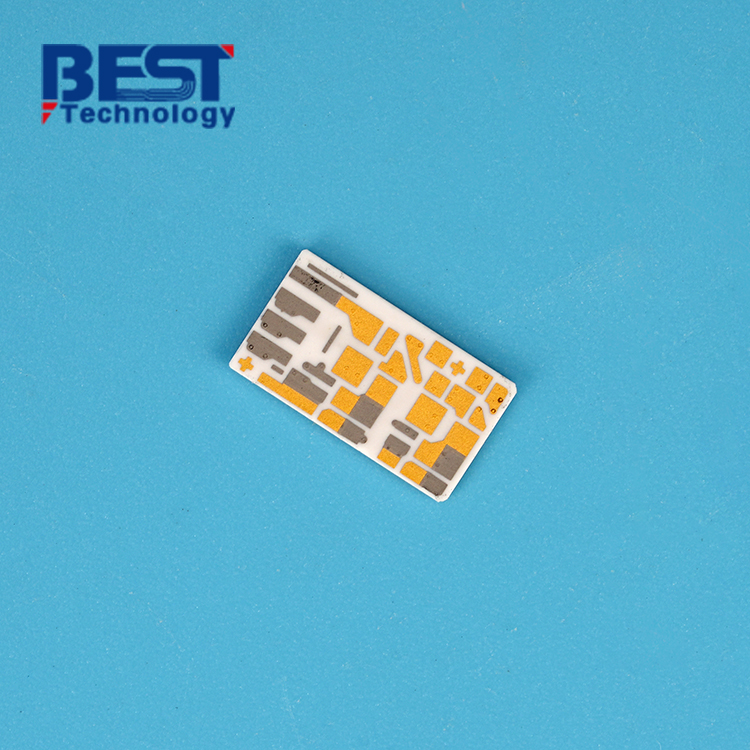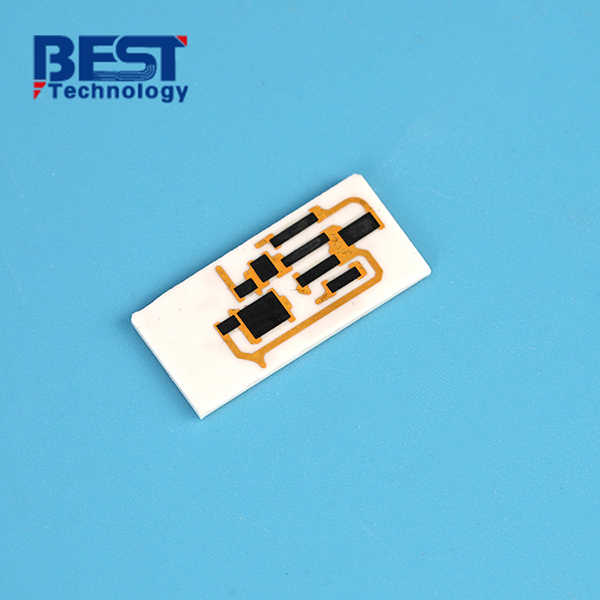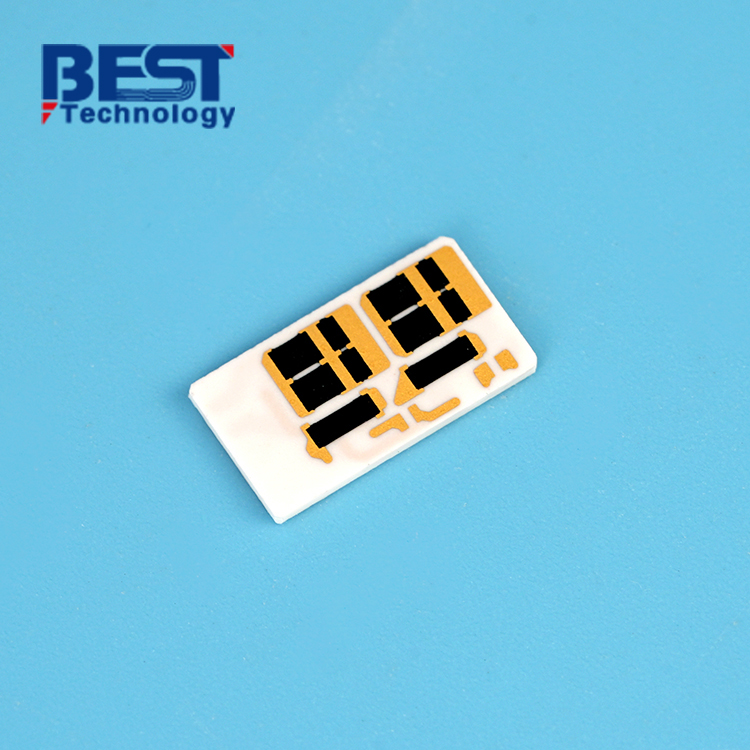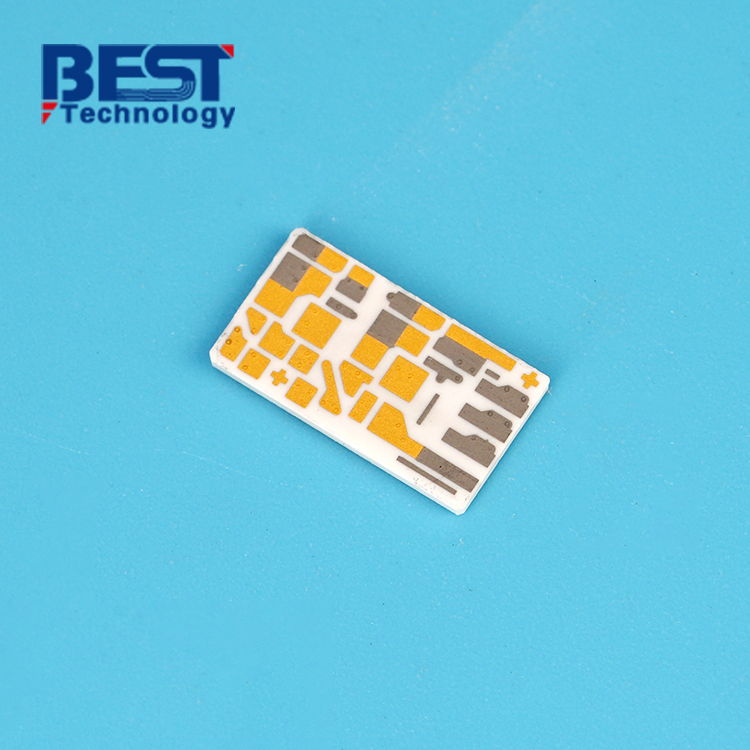
Low-temperature Co-fired Ceramic Substrate PCB For Sensor






Board Thickness: 0.635mm+/-0.1mm
Conductor: 10-15um AgPd 3-5mm Au
Solder Mask: N/A
Silkscreen: N/A
Surface Finishing: N/A
Application: Sensor
| Item1 | LTCC Capabilities | |||||
|---|---|---|---|---|---|---|
|
Layer Count |
4-64 Layers |
|||||
|
Max Board Dimension |
150mm×150mm |
|||||
|
Min Board Thickness |
Single layer 0.1mm, total thickness 0.15mm |
|||||
|
Max Board Thickness |
Single layer 0.25mm, total thickness 6mm |
|||||
|
Conductor Thickness |
6-12μm (the surface layer can be thickened to 80μm) |
|||||
|
Min Line Width/Line Space |
150μm (surface layer can be refined to 50μm) |
|||||
|
Substrate Type |
Al2O3 |
|||||
|
Substrate Thickness |
0.15-6mm |
|||||
|
Min Hole Diameter |
100μm |
|||||
|
Min Hole Spacing |
250μm |
|||||
|
Min PAD Ring(Single) |
0.125mm |
|||||
|
PTH Wall Thickness |
N/A |
|||||
|
Min Solder PAD Dia |
0.1mm |
|||||
|
Min Soldermask Bridge |
75μm |
|||||
|
Min BAG PAD Margin |
0.635mm |
|||||
|
PTH/NPTH Dia Tolerance |
10μm |
|||||
|
Hole Position Deviation |
30-40μm |
|||||
|
Outline Tolerance |
Laser cutting: 0.005; Die stamping: 0.005 |
|||||
|
Line Width/Spac Tolerance |
±20% |
|||||
|
Surface Treatment |
Immersion Gold/Nickel Palladium Gold (Surface treatment is not recommended) |
|||||
|
Thermal Stress |
7.3ppm/K |
|||||
| Item2 | Attribute | ||
|---|---|---|---|
|
Base Material |
DP951,DP9K7, Ferro-A6-M |
||
|
Base Material Thickness (exclude conductor) |
0.15-6mm |
||
|
Thermal Conductivity |
17W/mk |
||
|
Soldermask Type |
Aluminum Oxide |
||
|
Tg Value |
800℃ |
||
|
Halogen Free |
No |
||
|
Breakdown Voltage |
9.4 (1MHz); 9.1 (13GHz) |
||
|
Dielectric Constant (MHZ) |
≤0.5% |
||
|
Water Absorption |
0% |
||
|
ROHS |
Yes |
||
|
Flammability |
Grade A |
||
|
Thermal Conductivity (W/m.K, or W/m.C) |
17W/mk |
||
|
Dielectric Strength |
15KV/mm |
||
|
Wrap & Twist |
0.003 |
||
| Prototype(<1m²) | Layers | Normal Service | Expedited Service |
|---|---|---|---|
|
LTCC Ceramic PCB |
6 Layers |
6 - 8 weeks |
3 - 4 weeks |
|
8 Layers |
6 - 8 weeks |
3 - 4 weeks |
|
|
10 Layers |
6 - 8 weeks |
3 - 4 weeks |
|
|
>10 Layers |
6 - 8 weeks |
3 - 4 weeks |
| Mass Production | Layers | Normal Service | Expedited service |
|---|---|---|---|
|
LTCC Ceramic PCB |
6 Layers |
7 - 9 weeks |
4 - 5 weeks |
|
8 Layers |
7 - 9 weeks |
4 - 5 weeks |
|
|
10 Layers |
7 - 9 weeks |
4 - 5 weeks |
|
|
>10 Layers |
7 - 9 weeks |
5 - 6 weeks |

LTCC ceramic PCBs (Low-Temperature Co-Fired Ceramic Printed Circuit Boards) have become a game-changer in the world of electronics. Their exceptional performance, reliability, and versatility have revolutionized various industries. In this article, we will delve into the applications of LTCC ceramic PCBs and highlight their potential to outperform traditional PCB solutions in different fields.
1. Aerospace and Defense
LTCC ceramic PCBs are widely used in the aerospace and defense industries due to their reliability, durability, and miniaturization capabilities. They are instrumental in satellite systems, avionics, missile guidance systems, and radar technology, delivering uninterrupted operation and precise functionality in harsh environments.
2. Automotive
With the rise of electric vehicles, LTCC ceramic PCBs are driving innovation in the automotive industry. These PCBs are ideal for power electronics, sensor modules, lighting controls, and other applications. Their high thermal conductivity, excellent electrical performance, and compact form factor contribute to more efficient and reliable automotive systems.
3. Medical Devices
LTCC ceramic PCBs have become a vital component in the development of advanced medical devices. Their biocompatibility, high-frequency capabilities, and miniaturization potential enable the creation of implantable medical devices, diagnostic equipment, and wearable health monitoring systems. These PCBs empower medical professionals to deliver precise diagnoses and improved patient care.
4. Internet of Things (IoT)
LTCC ceramic PCBs play a crucial role in the Internet of Things (IoT) by providing the foundation for connected devices. Their high integration density, RF compatibility, and low power consumption make them essential for smart homes, industrial automation, and environmental monitoring systems. LTCC ceramic PCBs bring us closer to a fully connected world.
5. Telecommunications
In the telecommunications industry, LTCC ceramic PCBs offer unmatched performance and reliability. They are used in base station modules, RF amplifiers, microwave filters, and wireless transceivers. These PCBs ensure seamless communication, enabling the evolution of 5G networks and beyond.
6. Industrial Applications
LTCC ceramic PCBs are driving innovation in the industrial sector by increasing efficiency, productivity, and automation. They are used in power electronics, motor controls, sensor interfaces, and control systems. These PCBs provide exceptional thermal management, power handling capabilities, and reliability, supporting the development of advanced industrial machinery and smart factory environments.
Background:
AeroTech Dynamics is a leading aerospace company specializing in the development of advanced technologies for space exploration and aviation. They required a reliable and high-performance PCB solution for their aerospace applications, where stringent requirements for reliability, thermal management, and signal integrity were critical.
Project Challenges:
AeroTech Dynamics faced several challenges in their aerospace projects, including the need for lightweight and compact designs, resistance to high temperatures and vibrations, and precise signal transmission in harsh environments. They sought a PCB technology that could meet these challenges and ensure optimal performance and reliability in aerospace applications.
Solution:
We collaborated closely with AeroTech Dynamics to develop LTCC ceramic PCBs specifically tailored to their aerospace needs. Leveraging the unique properties of LTCC ceramic material, we provided customized solutions to address their challenges effectively.
Our Professional Approach:
Lightweight and Compact Designs: LTCC ceramic PCBs enabled AeroTech Dynamics to achieve lightweight and compact designs without compromising performance. We optimized the PCB layout, leveraging the high integration capabilities and design flexibility of LTCC technology to minimize size and weight, crucial factors in aerospace applications.
High-Temperature Resistance: Aerospace environments often involve extreme temperatures. We utilized the excellent thermal stability and heat dissipation properties of LTCC ceramic material to ensure reliable operation in high-temperature conditions. Our engineered solutions included thermal vias, copper heat sinks, and optimized component placement to manage heat effectively.
Signal Integrity in Harsh Environments: AeroTech Dynamics required precise signal transmission and immunity to electromagnetic interference (EMI) in the demanding aerospace environments. We implemented advanced design techniques such as controlled impedance routing, EMI shielding, and noise reduction strategies to maintain signal integrity and minimize the impact of external interferences.






















































 HOME
HOME










